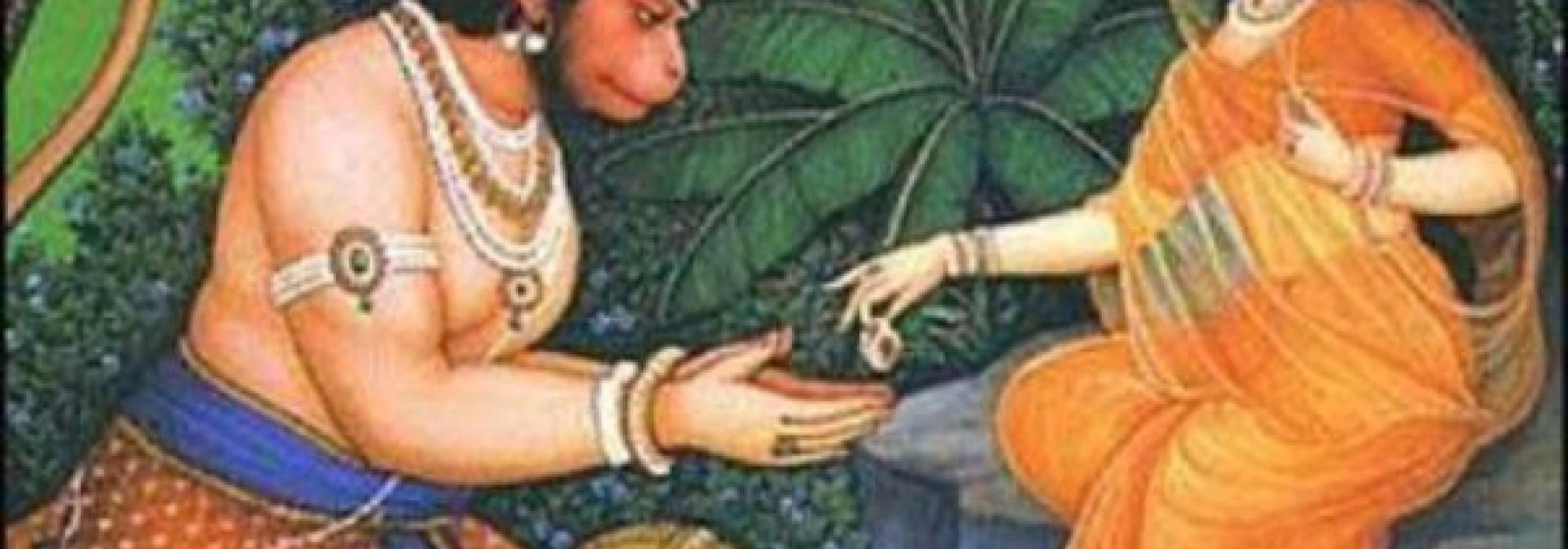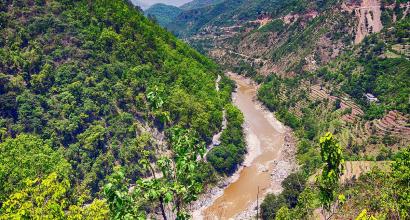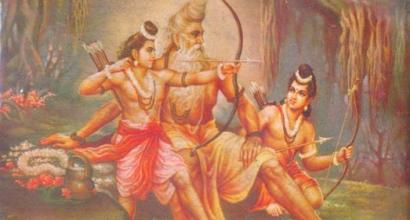Hanūmān, who was hiding behind the branches of the tree, had thus seen and heard everything that had taken place there. He thought, ‘I have found Sītā, but I must not go back without reassuring her. If I don’t do so, she will not survive the night. I must also take her message to Rāma. Let me wait until the rākṣasīs slacken their vigilance. I probably must speak to her employing Saṃskṛta – the cultured language familiar to the humans. But then, she might take me for Rāvaṇa if I speak to her in Saṃskṛta and get frightened. She might get terrified looking at me and cry out, taking me for Rāvaṇa in disguise. And if she shouts, the rākṣasīs will rush to her and will try to capture me. They might even slay Sītā. If I am captured or put to death, who will convey my message to Rāma and Sugrīva? These are the risks in my speaking to Sītā, but I cannot remain here, without reassuring her. If I speak to her about her husband Rāma, she will not get frighten by me, perhaps!”
After deliberating for long, the great vānara uttered sweet words such that Vaidehī could hear them. “There lived a king of great renown, Daśaratha, who was devoted to non-injury, truth, and valour. His eldest son, Rāma was the most learned, and protected dharma. Upon the orders of his father, he went to live in the forest with his wife and brother. There, Jānakī was abducted by Rāvaṇa, who was enraged that Rāma had killed Khara and Dūṣaṇa. And now, I have found her and she is just as Rāma described her.”
Immensely astonished to hear these words, Sītā looked up at the śiṃśapā tree and spotted the vānara; but the next moment she thought, This must be a dream, and lost consciousness. After a long time, she regained consciousness and thought, I just had a horrible dream! The śāstras declared that seeing a monkey in a dream is inauspicious. I hope no evil befalls Rāma, Lakṣmaṇa, or my father Janaka! Well, no, this cannot be a dream, as I cannot even sleep. I cannot rest, separated from my beloved. As I constantly think about him, I seem to see and hear him at all times; this must be a hallucination, and yet, I am able to reason properly. The creature who is speaking thus has a clearly discernible form. My salutations to Bṛhaspati, Indra, Agni, and Brahmā. May the words of this creature be true and not otherwise!
Hanūmān then jumped down from the tree and spoke to Sītā, his hands joined above his head. “Who are you, divine lady, and why do you cry? Are you grieving for your son, brother, father, or husband? You look like a queen. Please tell me, are you Sītā, who was abducted by Rāvaṇa from Janasthāna?” Sītā was thrilled and narrated everything that had taken place. Hanūmān spoke comforting words to her, “I am Rāma’s messenger. He is well and enquires about your well-being too, Vaidehī. His brother, Lakṣmaṇa, bows his head in salutation to you.”
With joy passing through her body as a tremble, Sītā said, “Indeed, it seems like the popular gāthā is true – Joy eventually comes to a person who is alive, even if it takes a hundred years!”
Hanūmān went closer to her to console her. But the closer he came, the more Sītā suspected that he was Rāvaṇa in disguise. She collapsed on the ground overcome with fear. Hanūmān, however, prostrated before her. Heaving a deep sigh, she said, “If you are Rāvaṇa, employing illusion to torture me, please stop doing so. But if you are really a messenger of Rāma, describe him to me, for I love to hear about him. What a dream this is! Well, not a dream or a hallucination. I can clearly see myself and this forest creature!” Hanūmān then described Rāma’s noble qualities and said, “You will soon see Rāghava vanquishing Rāvaṇa. He now has an ally, Sugrīva, the lord of vānaras. I am Hanūmān, his minister. I have crossed the ocean and come to Laṅkā to see you, and by doing so, I have placed my foot on the head of the wicked Rāvaṇa! I am not what you think, devi, don’t be scared! Trust me!” Upon her request, Hanūmān described the physical beauty of Rāma and Lakṣmaṇa as well as their divine character and prowess. He also narrated in detail the manner in which Rāma befriended Sugrīva, Rāma’s distress and longing for his beloved as well as the story of his own birth. He then said, “Devi, look at this ring engraved with Rāma’s name. Gather courage, for your troubles will soon end.”
As she received the ring that had adorned her husband’s hand and looked at it, Jānakī was as happy as being reunited with him. Her lovely face lit up with joy and shone like the moon, released from the clutches of Rāhu. Delighted at the message from her husband and feeling grateful for having heard such wonderful news, she said, “You seem to be really valiant, strong, and wise, O vānara, for you have single-handedly breached this stronghold of the rākṣasas. The mighty ocean was but a puddle in a cow’s hoof-print to you and you crossed it in a single leap. You are not ordinary, for you don’t have the slightest fear for Rāvaṇa. I hope Rāma does not abandon himself to grief and suffering and is busy gathering allies. I trust that Rāghava has not stopped loving me for I am far away from him. He will surely rescue me from this hell. I hope he still receives news about the well-being of Kausalyā, Sumitrā, and Bharata. No one is dearer to him than I; not even his mother or his father. I wish to live only so long as I hear the news of my beloved.”
Holding his hands joined on the top of his head, Māruti said, “Rāma does not know that you are here. Once he hears what I have to say, he will cross over the ocean with his huge army of vānaras, destroy Laṅkā, and take you back. I swear by the mountains, roots, and fruits that you will soon see Rāma’s handsome face. With you away from him, he does not eat meat nor drink honey-wine; he consumes only boiled rice and food from the forest only once a day. His heart is so absorbed in you that he does not even drive away mosquitoes and insects that bite his body. He almost never sleeps but even when he falls asleep by chance, he wakes up with a start calling ‘Sītā’ in a sweet voice. Whenever he sees a fruit or flower that is pleasing, he exclaims again and again with sighs, ‘Alas, my dear!’ He constantly calls your name, devi, and is putting every effort to get you back!”
Sītā said, “I am glad to know that there is no change in Rāma’s heart. But when will he cross over his sea of sorrow, like a shipwrecked sailor exhausted in the sea? You must ask him to make haste because I will survive only until the year allotted to me by Rāvaṇa has elapsed. It is the tenth month already and I am left with just two months! Rāvaṇa’s brother Vibhīṣaṇa tried hard to persuade him to send me back but he would not listen. All this was related to me by Vibhīṣaṇa’s eldest daughter Analā, who was sent by her mother. Rāvaṇa would not even listen to the sane advice of the wise and elderly Avindhya, though he holds him in high esteem. My beloved husband never gets daunted by difficulties. The heroic Rāma, the Sun with arrows for his rays, will soon dry up the water in the form of his rākṣasa foes!” With these words, she shed tears.
Hanūmān said, “As soon as Rāghava hears what I have to say, he will come to your rescue. But, I can myself free you from this place. Just climb on my back and I will take you to Rāma just as Agni takes the havya to Śakra. Once I set forth, nobody from Laṅkā will be able to follow me. Just climb over my back, Vaidehī!”
Maithilī was astonished hearing his words; she asked, “Your body is so tiny! How can you even think of carrying me that far?” Considering this as a belittlement of his power, Hanūmān began to grow in size to instil confidence in Sītā. He became as huge as a mountain and said, “I can carry the whole of Laṅkā, including its palaces and gateways as well as its lord himself. Come with me, devi, and relive Rāma and Lakṣmaṇa from their sorrow!”
Sītā then said, “I now realise your strength and power, O vānara, but it would not be right for me to come with you. I might faint as you fly through the sky with the speed of the wind; or I might fall from your back. The rākṣasas will surely pursue you and you would be placed in danger. As you fight then turning the other way, I might fall from your back; then the rākṣasas may again abduct me and place me in an inaccessible place. Moreover, you might be capable of vanquishing all rākṣasas single-handedly but that will eclipse Rāghava’s reputation. I am devoted to my husband, O vānara, and would not willingly touch the body of any other man. Yes, I was forced to touch Rāvaṇa’s body but I was helpless. It would be more fitting if Rāma rescues me by himself by vanquishing Daśagrīva and his rākṣasas. No one can face my husband in a battle. Please bring him here soon!”
Delighted with Sītā’s words, Hanūmān said, “What you say is certainly befitting a chaste woman! Yes, it is indeed difficult for a woman to cross over the ocean clinging on to me. Moreover, the second reason you offered, devi, that you will not touch any man other than Rāma, is appropriate for you as the wife of such a noble man. What woman other than you could say so? I will tell everything that you have said to Rāma. I told you about my capabilities only out of my affection and to be of some help to you and Rāma. I wanted to reunite the two of you immediately. As you will not come with me, please give me a token of identity that Rāma will recognise.”
Sītā replied in a soft voice, choking with tears, “You can tell my beloved of this incident that will serve as the best means of identification. ‘Once, when we were residing in the North-eastern foothills of Mount Citrakūṭa close to the river Mandākinī, I came and sat on your lap, wet with water. You fell asleep on my lap. Then a crow, desirous of food started pecking me. I picked up a lump of mud, and heaved at the bird to drive it away. But greedy of food, the crow did not stop tearing at my flesh. When, in my anger at the bird, I was tightening my girdle, my clothes fell open, and you happened to see me and made fun of me. Angered and embarrassed, I sat on your lap again. You seemed to enjoy the whole thing, but tried to pacify me as I was still angry. You saw that my face was wet with tears and I was wounded between my breasts. Seeing the crow at a distance, his claws dripping blood, you plucked a blade of darbha grass and invoked the power of brahmāstra in it. It chased after the crow, blazing like the kālāgni; the bird fled across the three worlds. Rejected by his father, devas, and maharṣis, it sought refuge in you. As the brahmāstra couldn’t be called back once fired, it took the crow’s right eye. The crow bowed down to you and left to his abode. For my sake, you released the brahmāstra against a mere crow! But still haven’t you come to rescue me now! You had told me that kindness is the highest dharma.’ Why hasn’t even Lakṣmaṇa come to my rescue upon his brother’s orders? He, who always considered Rāma as his father and me as his mother, did not know that I was getting abducted. He is just like my father-in-law and is foremost in the service of others. For Rāma, Lakṣmaṇa was always dearer than I. Having him by his side, Rāma does not miss his dead father. You must tell again and again to Rāma that I will survive only for one more month. Please ask him to rescue me.”
Then taking out her divine cūḍāmaṇi – crest-jewel, which she had wrapped in her garment, Sītā handed it to Hanūmān and asked him to give it to Rāghava. The heroic vānara reverentially received the ornament and put it on his finger. He went in a pradakṣiṇa around Sītā and bowed down to her. He was so delighted that he stood there only in his body, for he had already travelled in his heart to Rāma.
Sītā said, “When Rāma sees this, he will be reminded of three people: my mother, myself, and King Daśaratha. Please convey my greetings to Rāma, Lakṣmaṇa, Sugrīva, and all the other vānaras. Stay back for another day, if you please. Once you have rested in a safe spot, you can depart tomorrow. Your presence will provide me a moment’s respite from my sorrow. Moreover, I still have a doubt. How will the huge army of the vānaras along with my beloved cross the ocean? Only you, Garuḍa, and Vāyu can cross the vast ocean. You can accomplish the mission single-handedly; you will gain immense glory. However, only if Rāma and his entire army rescue me after defeating Rāvaṇa, will that add to his reputation and I feel that is the best way forward. Therefore, ensure that the great hero demonstrates his valour that is worthy of him.”
Hanūmān then said, “Sugrīva has made his resolve and mobilised a huge army of vānaras; and those creatures of immense power do not shy away from any kind of tasks. They move as fast as thought and have gone in a pradakṣiṇa around the earth many times. All vānaras are superior to me in strength or at least equal to me. The mighty brothers will come for you, mounted on my back. Stop lamenting lady! You will not remain here for long!”
Sītā replied, “I am relieved upon seeing you, vānara! Please give this token of recognition to Rāma and remind him of the blade of grass that he hurled at the crow. You must also remind him of the red tilaka of manaḥśilā that he placed on my cheek, when the tilaka on my forehead had by chance been wiped off. Please bring Rāma here soon! May you have a safe journey, valorous vānara!”
To be continued...
[The critically constituted text and the critical edition published by the Oriental Institute, Vadodara is the primary source. In addition, the Kannada rendering of the epic by Mahāmahopādhyāya Sri. N. Ranganatha Sharma and the English translation by Sri. N. Raghunathan have been referred.]











































